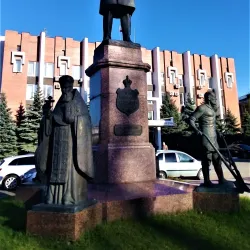Crime and Pollution in Saratov
The following data and statistics on crime, pollution, and overall safety in Saratov are derived from a combination of trusted public sources and insights gathered from over 18 user contributions.
This comprehensive approach helps provide a balanced view of the city's crime rates, environmental concerns, air quality, and public safety. By aggregating information from government reports, environmental studies, and direct feedback from residents, we aim offer an up-to-date and thorough analysis of key factors impacting quality of life in Saratov.
Crime Data in Saratov
Crime Perception and Concerns
In 2024, Saratov continues to face moderate crime concerns. While the crime index indicates some level of safety, residents have varying experiences and worries depending on the crime type and time of day.
The general perception of safety is mixed, with higher confidence in safety during daylight and notable concerns after nightfall.
Some notable concerns include:
- Property CrimesConcerns regarding property crimes, including theft and home break-ins, are relatively low. Residents do not perceive these as major threats, contributing to a moderate crime index.
- Drug-Related IssuesDrug-related problems are not considered a significant issue in Saratov, indicating a relatively stable situation compared to other crime aspects.
- Violent CrimesViolent crimes appear to have a significantly low impact on public perception, with many residents not viewing these as primary concerns, thus reducing the overall fear of violence.
- Public SafetyMany in Saratov feel quite safe during daylight hours, but the safety assurance decreases substantially at night, as indicated by higher concerns about potential attacks and nighttime security.
Crime Trends and Safety
- Rising Crime ConcernsWhile there is some perception that crime may be on the rise, the concerns are not profoundly alarming. Attention to corruption and bribery remains a significant area where public dissatisfaction is noted.
- Specific FearsSpecific fears are low regarding most crime aspects, but there is a notable concern about being attacked or insulted. Issues of discrimination based on skin color, ethnicity, or religion are minimal.
Crime Rankings
Pollution Data in Saratov
Air Quality and Pollution Levels
Saratov is grappling with significant air quality challenges in 2024, influencing public health and well-being, especially in urban centers where pollution is most prevalent.
Although particulate matter levels like PM2.5 and PM10 are reported as zero, public perception does not align, suggesting possible discrepancies in measurement or communication.
- PM2.5 (Fine Particulate Matter)Despite official reports indicating no PM2.5 levels, public concern about air quality remains high, signaling a need for greater transparency or better environmental measures.
- PM10 (Coarse Particulate Matter)Similarly, a zero reading for PM10 fails to assure the public, as residents continue to express discontent with the air quality impacting their everyday life.
Waste and Noise Pollution
Waste management issues are a major point of concern, with extensive dissatisfaction driving calls for more effective garbage disposal methods and cleaner urban environments.
Noise and light pollution are not reported as serious issues, but the overall quality of cleanliness is significantly questioned by the inhabitants.
- Garbage Disposal SatisfactionA major dissatisfaction area is garbage disposal, where residents feel that the current systems are insufficient, leading to unclean environments detrimental to the city's image.
- Noise and Light PollutionWhile noise pollution does not feature prominently in complaints, the contribution of waste and cleanliness issues overshadow this aspect in Saratov.
Green Spaces and Water Quality
Saratov's green spaces currently do not meet residents' expectations, limiting their use as recreational and relaxation areas.
Though water quality is perceived as accessible, there is room for significant improvement in overall purity and satisfaction among residents.
- Green and Parks QualityPublic satisfaction with green spaces is low, with residents expressing a need for more investments in parks and recreational areas to enhance the city’s livability.
- Drinking Water QualityDrinking water, while accessible, does not receive high praise, indicating issues with quality that may affect public trust and overall satisfaction.

















